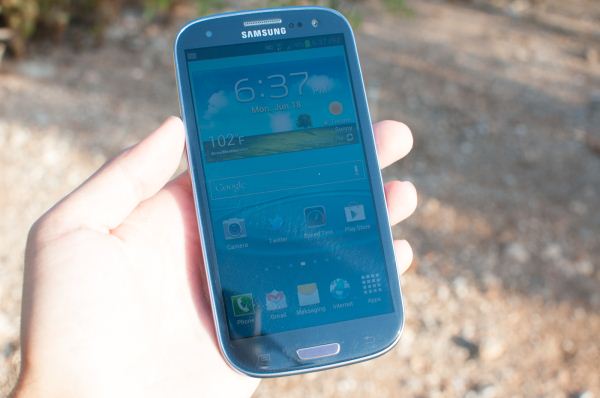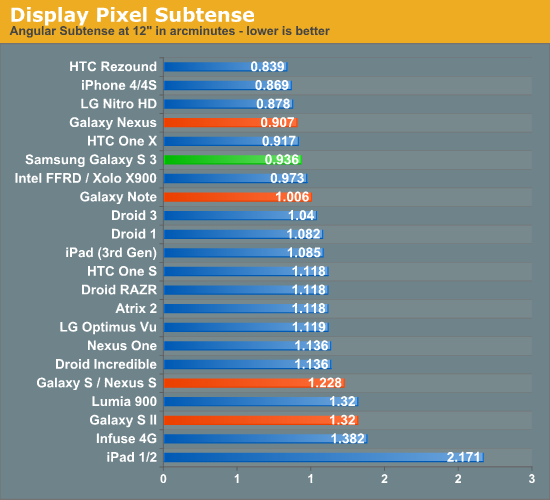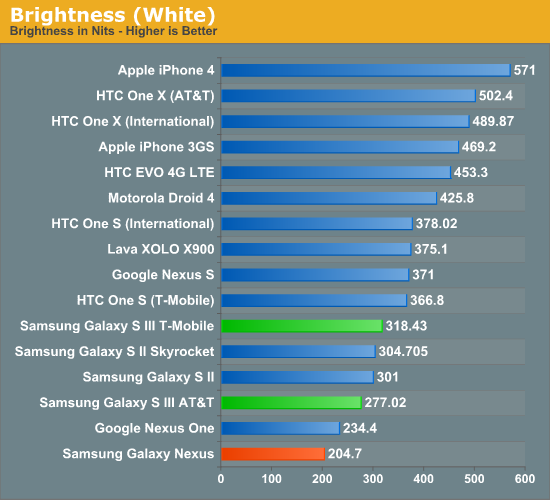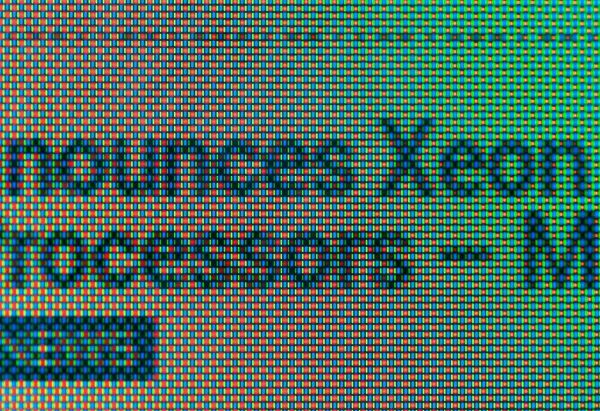Samsung Galaxy S III Review - AT&T and T-Mobile USA Variants
by Brian Klug on June 20, 2012 12:01 AM ESTOne of the standout features on the SGS3 is the 4.8" HD SAMOLED display, which has an effective resolution of 1280x720. Like other Samsung devices, the name tells you almost everything you need to know: HD connotes 720p, S for Super means the stack is optically bonded with fewer air gaps (and thus fewer fresnel 4% back reflections), and the lack of Plus means it’s an RGBG PenTIle subpixel matrix.
First off, it’s clear to me that the SGS3 display is a substantial improvement on the Galaxy Nexus display, which was 4.65" diagonal and also 720p HD SAMOLED. The problems that I talked about in the Galaxy Nexus display are basically completely absent in the SGS3. There’s no longer any mura (luminance variance which looks like noise) or a weird purple cast in the greys, two things that are still present on the Galaxy Nexus. I suspect that moving to a larger display with the same resolution (and thus larger subpixels) might have helped mitigate some of the mura, and in addition this appears to be a completely new revision of the process with none of those problems.

Outdoor viewing angles are pretty darn good
I think it’s also worth discussing PenTile once more - specifically in the context of whether or not you can see the pixels. At this point, I don’t think we need to go over what it is in much detail, but that it uses two sets of two subpixel units to achieve higher effective resolution than an RGB stripe. There are two variants - RG, BW which I’ve seen in a few Motorola LCD displays (that are Samsung), and RG, BG, which is the more common variant that is in all the AMOLED panels without the “plus” suffix.
The implementations that I complained loudest about were really the Nexus One and Nexus S / Galaxy S, where AMOLED was still somewhat in its infancy, and RG, BG was both a way to increase subpixel lifetime before fading took place (according to Samsung), and achieve a higher logical resolution with fewer subpixels than an RGB stripe would require. For that reason, you can’t really just evaluate a display with some boolean is garbage / not garbage based on the presence of PenTile alone. In theory, if the logical two-pixel cell is itself smaller than human visual acuity, then you shouldn’t be able to see it, and seeing the pixels is what drove me crazy about those two phones.
I present the following graph, which has the angular subtense in arcminutes along the stripe (when a device is held portrait, this is the x direction) of one logical pixel. That is to say, two subpixels if we’re talking about an RGBG PenTIle display, or three for an RGB display. For reference, human visual acuity is most often cited as being around 1 arcminute for the human vision system corrected to 20/20, which isn’t perfect vision (20/15 or slightly better is). Anything below that should be indistinguishable at a distance of 12 inches (standard viewing distance).

This is what I’m talking about when I say that in implementations such as the SGS3, even though PenTile is present, the logical pixel is still smaller than visual acuity, and the subpixels are half that. There’s still a case to be made for whether you can see fringing on black text on a white background to some extent, but personally I cannot see it.
So how is the display in other terms, such as brightness, color rendering, and viewing angles? For this I turned to the combination of my display colorimeter (still an i1D2), ColorHCFR, and Francois’s excellent Voodoo Screen Test Patterns.
When it comes to brightness, I found that oddly enough the T-Mobile and AT&T devices differed by a measurable and repeatable margin. Possibly these are from completely different batches, possibly there is some optimization done for the display brightness dynamic range to conserve battery - I’m not sure. Either way, it’s there, but the SGS3 is thankfully brighter than the Galaxy Nexus, though it still seems to be clamped to a fairly conservative number.

I measured blacks a few times and tried to see if I could get a reading on whether the SGS3 also has a slight DC bias (not fully off), but still couldn’t get anything. If it’s there, I haven’t noticed it yet.
In the Color HCFR testing, we can see that gamma looks very weird and nonlinear across the greys, going from around 2.4 down to 1.2, I have no idea what’s going on here. Color temp is thankfully a bit more controlled, at just under 7000K, and relatively flat.

I measured both devices after seeing that there was variance, and uploaded the color.chc files for both the AT&T and T-Mobile model for people with HCFR installed to check out. I’ve also made two galleries for the respective panels. I’ve heard really good things about the International SGS3 from Francois (supercurio), but haven’t measured it yet. I guess these initial numbers make me suspect that like SGS2 the USA variants have differences in the display rendering. I will say that over a range of brightnesses the SGS3 seems to have much less of the color shift compared to other AMOLEDs I’ve seen in the past.























107 Comments
View All Comments
themossie - Thursday, June 21, 2012 - link
You still see used Droid X (released 23 months ago) selling for $150 on Craigslist. Droid 2, released a month later, often sell for $125. Can recoup what you paid for them (contract prices) after 2 years? Not bad at all.I've made a pretty penny buying used phones cheap off Craigslist, using them, then flipping them 6-12 months for profit. Then you get events like the Windows Phone Challenge...
steven75 - Friday, June 22, 2012 - link
Just looked at ebay completed listings for Droid X. Average completed sale price is about $75.In comparison looked at iPhone 4 16 GB (released shortly after the X and the average completed sale price is about $250.
themossie - Saturday, June 23, 2012 - link
eBay prices are cheaper than Craigslist. iPhone 4 averages ~$300 here (to the extent I can tell from my Craigslist experience!)Certainly not saying Android phones hold the resale value of iPhones! But I can consistently recoup what I paid (on contract) for the device.
zorxd - Thursday, June 21, 2012 - link
I agree. Who cares about how it "feels" anyway? I buy phones for their functionality, not their look.Also as you said, plastic is light and shock absorbant. Also it doesn't block RF. Seems like the perfect material for a phone. I honestly which we had less metal and glass and more plastic in phones.
shaolin95 - Wednesday, June 20, 2012 - link
Comments like this make me wonder if people think phones are supposed to be used as hockey pucks....come on now.ProPhotoman - Tuesday, July 3, 2012 - link
No one wanted a 1 pound phone , so they used plastic to keep the weight down. They know that most will put a case on it anyway.metafor - Wednesday, June 20, 2012 - link
Battery life seems to lag behind the One X. Which is disappointing considering LTE will only make it worse. But since -- unlike HTC -- Samsung launched this on both T-Mobile and Verizon, that makes it the go-to phone for those who don't want to jump on AT&T.Impulses - Wednesday, June 20, 2012 - link
HTC really dropped the ball in not getting a decent One variant on VZW. The new Incredible's kind of a joke...Impulses - Wednesday, June 20, 2012 - link
Meh, they they're not too far behind either... I agree the numbers are slightly disappointing considering it has a larger battery, but it's also a removable battery which makes it a wash IMO. The Wifi vs 3G results are interesting, I thought one of the biggest highlights of AMOLED was how it could potentially save a lot of power over LCDs... I guess that doesn't really pan out unless you visit a lot of sites with black backgrounds tho. :pThe EVO LTE results are wild tho, they're all over the place (which is why it'd be really nice to have at least one CDMA SGS3 variant reviewed). If you were to look at the 3G results only you'd conclude the CDMA stack is just a battery hog, but then it still trails the US One X (which has a smaller battery) on the Wifi test while demolishing it (and almost everything else) in the hotspot test. Doesn't make any sense!
Same SoC & display as the One X (AFAIK), any theories?
metafor - Wednesday, June 20, 2012 - link
A few. The CDMA and WiFi datapath could be far less power hungry than the HSPA+ to WiFi. In fact, it may even be a different WiFi module altogether. Hell, even something unnoticeable -- like signal strength of the WiFi/CDMA antenna and whether they interfere with each or not -- can make a big difference as the radios have to work harder to get a good signal.Stuff like this is hard to design, debug and quantify, especially when multiple radio interfaces are at work.